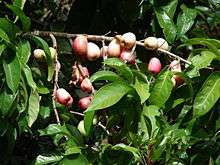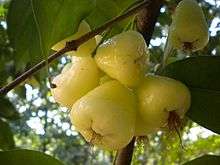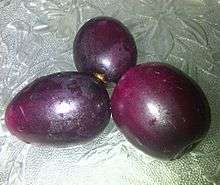Syzygium
Syzygium is a genus of flowering plants that belongs to the myrtle family, Myrtaceae. The genus comprises about 1200–1800 species,[3][4] and has a native range that extends from Africa and Madagascar through southern Asia east through the Pacific.[5] Its highest levels of diversity occur from Malaysia to northeastern Australia, where many species are very poorly known and many more have not been described taxonomically.
| Syzygium | |
|---|---|
 | |
| Syzygium malaccense | |
| Scientific classification | |
| Kingdom: | Plantae |
| Clade: | Tracheophytes |
| Clade: | Angiosperms |
| Clade: | Eudicots |
| Clade: | Rosids |
| Order: | Myrtales |
| Family: | Myrtaceae |
| Subfamily: | Myrtoideae |
| Tribe: | Syzygieae |
| Genus: | Syzygium R.Br. ex Gaertn.[1] |
| Species | |
|
About 1100; see List of Syzygium species | |
| Synonyms[2] | |
|
List
| |



Most species are evergreen trees and shrubs. Several species are grown as ornamental plants for their attractive glossy foliage, and a few produce edible fruits that are eaten fresh or used in jams and jellies. The most economically important species, however, is the clove Syzygium aromaticum, of which the unopened flower buds are an important spice. Some of the edible species of Syzygium are planted throughout the tropics worldwide, and several have become invasive species in some island ecosystems. Several species of Syzygium bear fruits that are edible for humans, many of which are named "roseapple". Fifty-two species are found in Australia and are generally known as lillipillies, brush cherries or satinash.[6]
At times Syzygium was confused taxonomically with the genus Eugenia (ca. 1000 species), but the latter genus has its highest specific diversity in the neotropics. Many species formerly classed as Eugenia are now included in the genus Syzygium, although the former name may persist in horticulture.[6] The Syzygium Working Group, an international group of researchers, formed in April 2016 with the aim to produce a monograph of Syzygium.[4]
Species

Selected species include:[7]
- Syzygium alliiligneum – onionwood (Queensland)
- Syzygium amplifolium
- Syzygium andamanicum
- Syzygium anisatum
- Syzygium anisosepalum
- Syzygium angophoroides
- Syzygium antisepticum – shore eugenia
- Syzygium aqueum – water apple, bell fruit, water cherry, watery rose apple
- Syzygium aromaticum – clove
- Syzygium australe – brush cherry (Australia)
- Syzygium beddomei
- Syzygium bourdillonii
- Syzygium canicortex – yellow satinash (Queensland)
- Syzygium caryophyllatum (type species)
- Syzygium chanlos (Gagnep.) Merr. & L.M.Perry
- Syzygium chavaran
- Syzygium cinereum (Kurz) Chantaran. & J.Parn.
- Syzygium conglomeratum
- Syzygium contractum
- Syzygium cordatum – Hute, waterbessie, undoni, water berry, umSwi
- Syzygium cordifolium
- Syzygium cormiflorum – Bumpy satinash
- Syzygium corynanthum – Sour cherry
- Syzygium corynocarpa (A.Gray) C.Muell.
- Syzygium courtallense
- Syzygium crebrinerve – Purple cherry, black water gum
- Syzygium cumini (L.) Skeels – Jambul, Jambolan, Black plum, Damson plum, Duhat plum, Jambolan plum, Portuguese plum
- Syzygium curranii – Lipote
- Syzygium densiflorum
- Syzygium diffusum
- Syzygium discophorum
- Syzygium duthieanum
- Syzygium dyerianum
- Syzygium elegans
- Syzygium erythrocalyx – Johnstone River satinash, Red Bud satinash
- Syzygium eucalyptoides
- Syzygium fergusonii
- Syzygium fibrosum – Fibrous satinash
- Syzygium fijiense
- Syzygium flosculiferum
- Syzygium forte – White Apple
- Syzygium formosanum – Native to Taiwan
- Syzygium francisii – Giant water gum, rose satinash
- Syzygium fullagarii (Lord Howe Island)
- Syzygium glaucum
- Syzygium gracilipes
- Syzygium graeme-andersoniae
- Syzygium grande – Sea apple
- Syzygium guehoi
- Syzygium gustavioides – Grey satinash
- Syzygium guineense – Waterberry
- Syzygium hodgkinsoniae – Red lilly pilly, smooth-barked rose apple (Australia)
- Syzygium jambos (L.) Alston – Roseapple, Malabar plum, plum rose, rose apple, water apple
- Syzygium jasminifolium
- Syzygium kemamanense
- Syzygium kiahii
- Syzygium koordersianum
- Syzygium kuranda – Kuranda satinash
- Syzygium leucoxylon
- Syzygium luehmannii – Riberry, cherry satinash
- Syzygium maire
- Syzygium makul
- Syzygium malaccense (L.) Merr. & L.M.Perry – Malay Apple, Malacca apple, Malay rose apple, mountain apple, Otaheite cashew, rose apple, water apple
- Syzygium manii
- Syzygium maingayi
- Syzygium megacarpum
- Syzygium micranthum
- Syzygium microphyllum (Syzygium gambleanum is an illegitimate synonym)
- Syzygium minus
- Syzygium monimioides
- Syzygium moorei – Coolamon, durobby
- Syzygium myhendrae
- Syzygium neesianum
- Syzygium nemestrinum
- Syzygium nervosum
- Syzygium oblatum (Roxb.) Wall. ex A.M.Cowan & Cowan
- Syzygium occidentale
- Syzygium oleosum – Blue lilly pilly
- Syzygium oliganthum
- Syzygium oreophilum
- Syzygium palghatense
- Syzygium paniculatum – Magenta lillypilly, magenta cherry (Australia)
- Syzygium parameswaranii
- Syzygium patentinerve (endemic to Savai'i & Upolu islands in Samoa)[8]
- Syzygium papyraceum – Paperbark satinash (Australia)
- Syzygium pauper
- Syzygium pendens
- Syzygium perakense
- Syzygium pergamentaceum
- Syzygium phaeophyllum
- Syzygium politum
- Syzygium polyanthum (Wight) Walp. – Indian bay leaf, Indonesian bay leaf, Salam leaf, daun salam, Indonesian laurel
- Syzygium pondoense
- Syzygium praineanum
- Syzygium pseudofastigiatum (Australia)
- Syzygium purpureum
- Syzygium quadrangulatum (A.Gray) Merr. & L.M.Perry
- Syzygium quadribracteatum
- Syzygium ramavarmae
- Syzygium revolutum
- Syzygium richii (A.Gray) Merr. & L.M.Perry
- Syzygium samarangense (Blume) Merr. & L. M. Perry – Java apple, makopa, Java rose apple, Samarang rose apple, water apple, wax jambu, wax apple
- Syzygium sandwicensis (A.Gray) Nied. – ʻŌhiʻa ha[9]
- Syzygium smithii
- Syzygium suborbiculare – lady apple]
- Syzygium syzygioides (Miq.) Merr. & L.M.Perry[10]
- Syzygium travancoricum
- Formerly placed in this genus
- Waterhousea floribunda (F.Muell.) B.Hyland (as S. floribundum F.Muell.)[11]
References
- "Genus: Syzygium R. Br. ex Gaertn". Germplasm Resources Information Network. United States Department of Agriculture. 2009-01-27. Retrieved 2011-01-26.
- "WCSP". World Checklist of Selected Plant Families. Retrieved March 8, 2014.
- Jie Chen and Lyn A. Craven, "Syzygium P. Browne ex Gaertner, Fruct. Sem. Pl. 1: 166. 1788", Flora of China Online, 13, retrieved 3 May 2015
- Ahmad, Berhaman; Baider, Cláudia; Bernardini, Benedetta; Biffin, Edward; Brambach, Fabian; Burslem, David; Byng, James W.; Christenhusz, Maarten J.M.; Florens, F.B. Vincent; Lucas, Eve J.; Ray, Avik; Ray, Rajasri; Smets, Erik; Snow, Neil W.; Strijk, Joeri S.; Wilson, Peter G. (2016). "Syzygium (Myrtaceae): Monographing a taxonomic giant via 22 coordinated regional revisions". PeerJ Preprints. doi:10.7287/peerj.preprints.1930v1. Retrieved 6 April 2016.
- Tuiwawa, S.H.; Craven, L.A.; Sam, C.; Crisp, M.D. (23 August 2013). "The genus Syzygium (Myrtaceae) in Vanuatu". Blumea. 58: 53–67. doi:10.3767/000651913x672271.
- Wrigley, John W.; Fagg, Murray A. (2003). Australian native plants: cultivation, use in landscaping and propagation (Fifth ed.). Australia: Reed New Holland. p. 696. ISBN 1876334908.
- "The Plant List: A Working List of All Plant Species". Retrieved 19 January 2014.
- Whistler, W. Arthur (1978). "Vegetation of the Montane Region of Savai'i, Western Samoa" (PDF). Pacific Science. The University Press of Hawai'i. 32 (1): 90. Retrieved 10 July 2010.
- Little Jr., Elbert L.; Roger G. Skolmen (1989). "'Ōhi'a ha" (PDF). United States Forest Service. Cite journal requires
|journal=(help) - Roskov Y., Kunze T., Paglinawan L., Orrell T., Nicolson D., Culham A., Bailly N., Kirk P., Bourgoin T., Baillargeon G., Hernandez F., De Wever A. (22 July 2013). "Catalogue of Life". Species 2000: Reading, UK.CS1 maint: uses authors parameter (link)
- "GRIN Species Records of Syzygium". Germplasm Resources Information Network. United States Department of Agriculture. Retrieved 2011-01-26.
- Craven, Lyndley A.; Biffin, E. (April 2010). "An infrageneric classification of Syzygium (Myrtaceae)". Blumea - Biodiversity, Evolution and Biogeography of Plants. 55 (1): 94–99. doi:10.3767/000651910x499303.
External links
| Wikimedia Commons has media related to Syzygium. |
| Wikispecies has information related to Syzygium |
